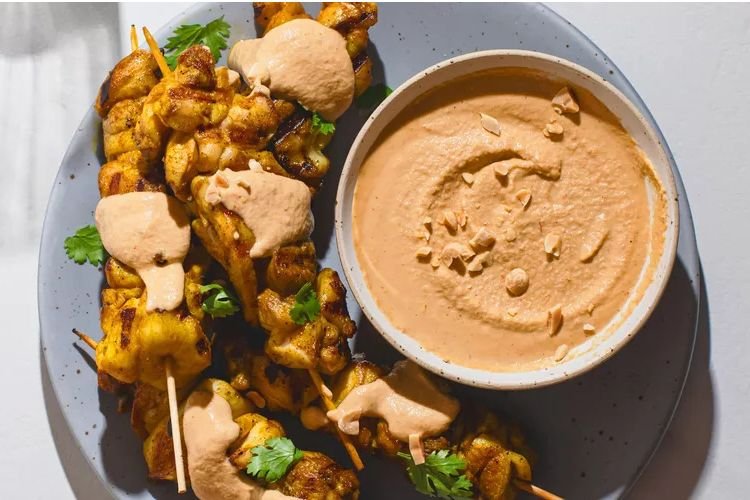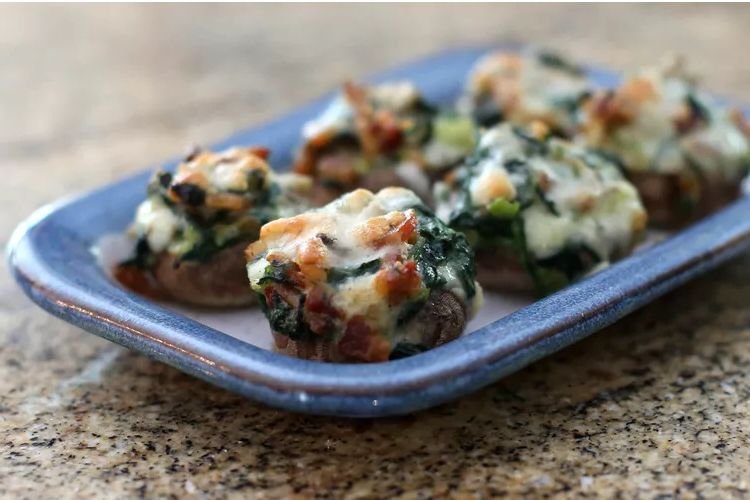Preparation Time: 10 minutes
Cooking Time: 0 minutes
Total Time: 10 minutes
Serves: 4 to 6
Makes: 1 1/2 cups
Satay sauce is a peanut sauce with a slightly spicy taste. Many people think of it as part of Thai food, but it’s enjoyed all over Southeast Asia and actually comes from Indonesia. The sauce is most famous for being served with satay, which is marinated meat like chicken, pork, or beef cooked on skewers. It’s a popular appetizer and a tasty dish that’s loved by many.
Making a yummy satay sauce at home is super easy and quick. You don’t need to cook anything for this recipe. All you have to do is put the ingredients in a blender or food processor, mix them together until smooth, taste it to adjust the seasoning, and it’s ready to use.
Most Western-style satay sauces use peanut butter as the main ingredient. But this recipe uses dry roasted, unsalted peanuts instead, and you’ll really notice the difference in flavor. Peanut butter often has added salt, sugar, or oil, which can change the taste. By starting with whole peanuts, you avoid those extras and have full control over what goes into your sauce, making it fresher and more natural.
Fish sauce gives the peanut sauce a salty and savory taste, brown sugar makes it sweet, and tamarind paste adds a tangy sourness. Cayenne pepper adds the spicy kick that makes the flavor stand out. When mixed together, these ingredients create a delicious balance of salty, sweet, tangy, and spicy flavors. You can adjust the taste to your liking, and this sauce is perfect for many different dishes.
Ingredients:
- 1 cup unsalted, dry roasted peanuts
- 1/3 cup water
- 1 to 2 cloves garlic, minced
- 1/2 teaspoon dark soy sauce
- 2 teaspoons sesame oil
- 2 tablespoons brown sugar
- 1 to 2 tablespoons fish sauce (or 1 1/2 to 2 1/2 tablespoons soy sauce)
- 1/2 teaspoon tamarind paste (or 1/2 tablespoon lime juice)
- 1/2 teaspoon cayenne pepper (or 1 teaspoon Thai chili sauce), adjust to taste
- 1/3 cup coconut milk
Steps to Make It
01
Make sure you have all the ingredients ready before you start.
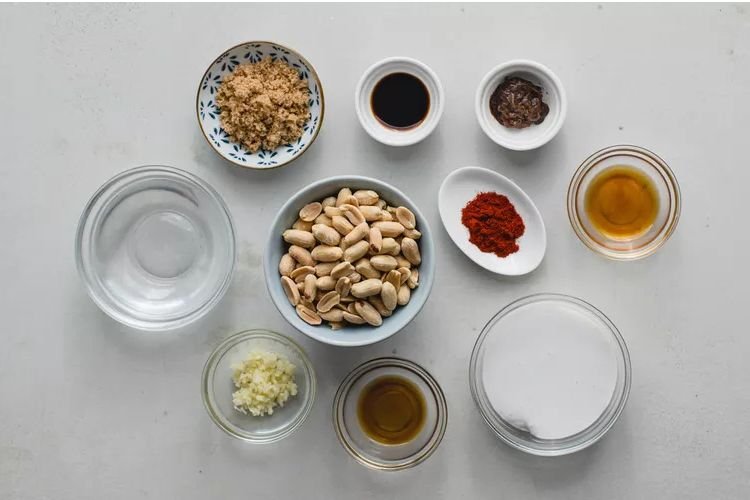
02
Put all the ingredients into a blender or food processor.
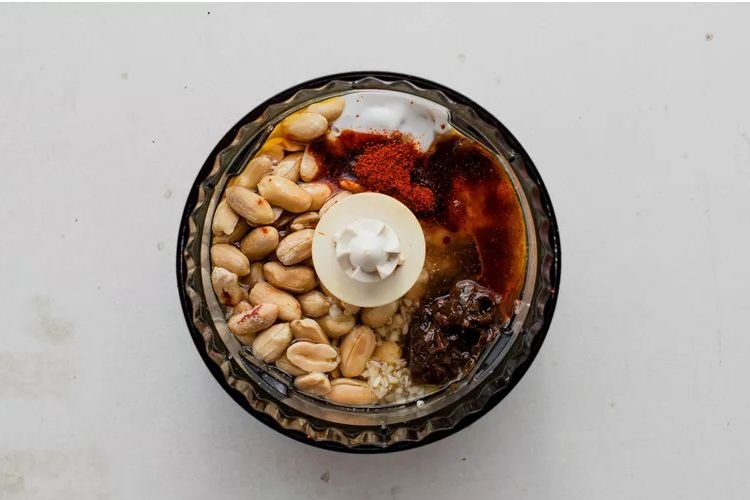
03
Blend or process the ingredients until the sauce is smooth. If you want the sauce to be thinner, add a little more water or coconut milk. Taste the sauce and make any changes to the flavor or thickness if needed.
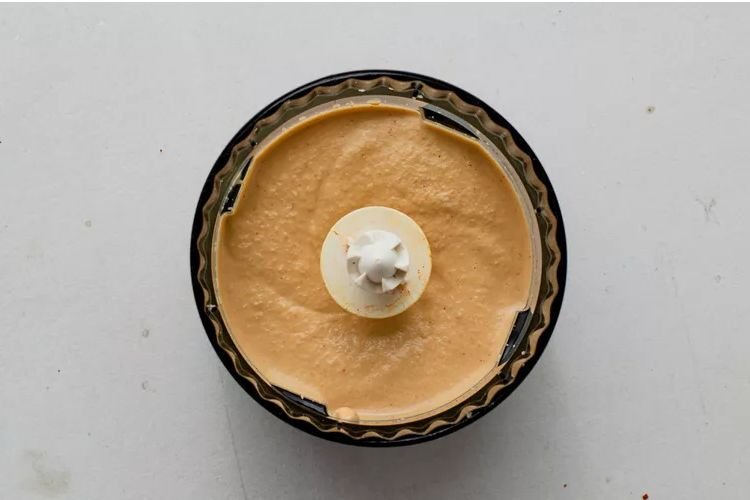
04
Serve the sauce either warm or at room temperature with chicken, pork, beef or vegetarian satay or use it with any dish you prefer. Enjoy your meal.
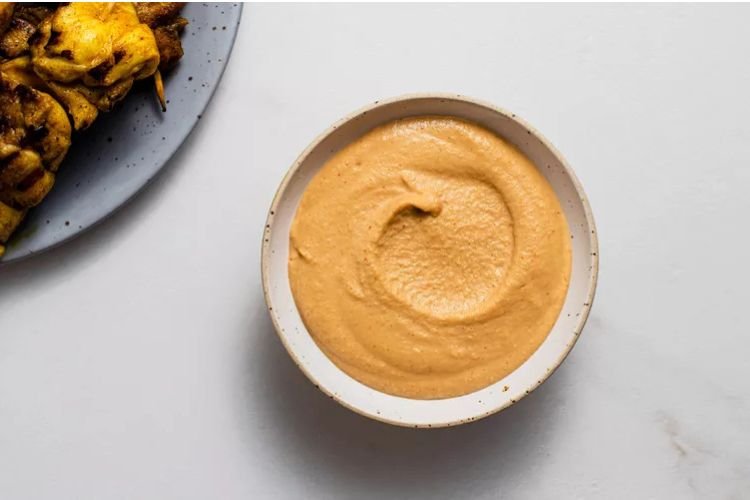
Tips
The most important part of making this sauce is getting the flavors just right. If you want to change the taste, try adding one of these ingredients:
- If it’s not salty enough, add more fish sauce or soy sauce.
- To make it spicier, add more cayenne pepper.
- If it tastes too salty, squeeze in some fresh lime juice.
- If you want it sweeter, add a little more sugar.
- If you’re making it vegetarian, use soy sauce instead of fish sauce.
- The sauce can get thicker as it sits, so if that happens, just add a little water or coconut milk to thin it out.
How to Store and Freeze Satay Peanut Sauce
You can keep satay sauce fresh by covering it and storing it in the refrigerator, where it will last for up to two weeks. If you want to save it for a longer time, you can freeze it. Just pour the sauce into ice cube trays and freeze it until solid. Once the cubes are frozen, move them to a freezer-safe bag or container. The sauce can stay in the freezer for up to six months and can be thawed whenever you need it.
Nutrition Facts (per serving)
Calories: 201
Fat: 16g
Carbohydrates: 10g
Protein: 7g
FAQs:
What Can You Serve Peanut Sauce With?
Thai Peanut sauce isn’t just for satay—it’s a versatile addition to many dishes. You can use it as a creamy and flavorful dressing for Asian-style salads or as a dipping sauce for fresh spring rolls. It’s also great for making cold noodle salads, giving them a rich and tangy flavor. You can marinate grilled chicken, tofu, or other proteins in it for a delicious meal. For a quick and healthy snack, try using it as a dip for fresh, crunchy vegetables like carrots, cucumbers, or bell peppers.
Can peanut sauce be used as a salad dressing?
Yes, peanut sauce makes an excellent Asian-inspired salad dressing. Simply thin the sauce with water, lime juice, or rice vinegar for a pourable consistency. It pairs well with crunchy greens, shredded cabbage, carrots, and fresh herbs like cilantro or mint. Adding peanut sauce to cold noodle salads or slaws gives them a bold, nutty flavor that elevates the dish.
Is Thai peanut sauce good for noodles?
Thai Peanut sauce is fantastic with noodles, whether hot or cold. It works especially well with rice noodles, soba, or udon, creating a creamy and satisfying dish. Cold noodle salads, such as Thai-inspired peanut noodles, are a refreshing and flavorful option. Add cooked vegetables, shredded chicken, or tofu for a complete meal.
Can I use peanut sauce as a dip for spring rolls?
Absolutely. Thai Peanut sauce is a classic dip for fresh spring rolls filled with vegetables, shrimp, or tofu. Its creamy texture complements the fresh, crunchy ingredients of the rolls. For fried spring rolls, the nutty richness of the sauce adds depth to the crispy exterior.
Can Thai peanut sauce be used with tofu?
Yes, Thai peanut sauce pairs beautifully with tofu. Use it as a marinade before grilling or baking tofu, or drizzle it over cooked tofu cubes. The sauce’s nutty and slightly tangy flavor enhances the mild taste of tofu, making it a great option for vegetarian dishes.
Can I use peanut sauce as a dip for raw veggies?
Peanut sauce is a perfect dip for raw vegetables like carrot sticks, celery, cucumber slices, and bell peppers. It’s a healthy and flavorful snack option, especially for kids or as a party platter addition. The creamy and slightly sweet sauce makes raw veggies more appealing.
Does peanut sauce pair with grilled chicken?
Peanut sauce is a classic pairing with grilled chicken, whether served on skewers, in wraps, or as a topping for grilled chicken breasts. Its rich, savory, and slightly sweet flavor complements the smoky char of grilled chicken perfectly.
Is Thai peanut sauce good for seafood?
Yes, Thai peanut sauce pairs surprisingly well with seafood like shrimp, grilled fish, or crab cakes. The creamy nuttiness balances the delicate, savory flavors of seafood, creating a unique and satisfying combination. It’s often served with grilled prawns in Asian cuisine.
Can I use Thai peanut sauce for wraps?
It is a versatile addition to wraps. Use it as a spread or drizzle for wraps filled with grilled chicken, beef, tofu, or fresh vegetables. Its bold flavor enhances the fillings and ties the ingredients together beautifully.
Is Thai peanut sauce suitable for rice dishes?
Yes, it pairs well with a variety of rice dishes. Drizzle it over steamed jasmine rice, add it to a rice bowl with vegetables and protein, or use it to flavor fried rice for a creamy, nutty twist.
Can Thai peanut sauce be used in burgers or sandwiches?
It can be a delicious and unexpected addition to burgers or sandwiches. Spread it on buns for a grilled chicken or pork sandwich, or use it as a topping for an Asian-inspired burger with pickled vegetables.
Can I use Thai peanut sauce for stir-fries?
Yes, it works wonderfully in stir-fries. Add it towards the end of cooking to coat vegetables, noodles, or meat. It creates a creamy, flavorful sauce that enhances the dish.
Does Thai peanut sauce pair well with potatoes?
it can elevate potato dishes by adding richness and depth. Drizzle it over roasted potatoes, use it as a dip for sweet potato fries, or toss it with boiled potatoes for a unique take on potato salad.
Can Thai peanut sauce be used in soups?
Yes, it can be incorporated into soups, particularly in Thai-inspired coconut-based soups like Tom Kha Gai or peanut soups. It adds a creamy texture and rich, nutty flavor. Simply stir it into the broth before serving.
Does Thai peanut sauce work with eggs?
Surprisingly, it is a great addition to egg dishes. Drizzle it over scrambled eggs, omelets, or boiled eggs for a unique flavor. It also pairs well with egg-based wraps or frittatas.
Can I serve Thai peanut sauce with dumplings or wontons?
Yes, it is an excellent dip for dumplings, wontons, or potstickers. Its creamy texture and savory-sweet flavor enhance the fillings of these Asian appetizers.
Can Thai peanut sauce be used for pizza?
It makes a delicious base for Asian-inspired pizzas. Spread it on pizza dough and top with grilled chicken, shredded vegetables, peanuts, and fresh herbs like cilantro.
Is Thai peanut sauce good for roasted vegetables?
It pairs beautifully with roasted vegetables like broccoli, cauliflower, sweet potatoes, or carrots. Drizzle it over the veggies after roasting or toss them in the sauce before serving.
Can Thai peanut sauce be served with bread?
Yes, It can be a dip for bread, flatbreads, or pita, especially as part of a fusion-style appetizer. It’s also a great accompaniment to naan or steamed buns.
Can I use Thai peanut sauce for tacos?
It is a fantastic addition to Asian-inspired tacos. Drizzle it over fillings like grilled chicken, pork, or tofu, along with crunchy vegetables and fresh herbs.
Can Thai peanut sauce be used with meatballs?
It is a flavorful glaze or dip for meatballs, especially those made with Asian spices. Serve it alongside as a dipping sauce or toss the meatballs in the sauce before serving.
Is Thai peanut sauce good for meal prep?
Yes, it is perfect for meal prep. Store it in the fridge and use it throughout the week as a dressing, marinade, or dip for pre-cooked vegetables, proteins, or grains. Its versatility makes it a staple for balanced, flavorful meals.

